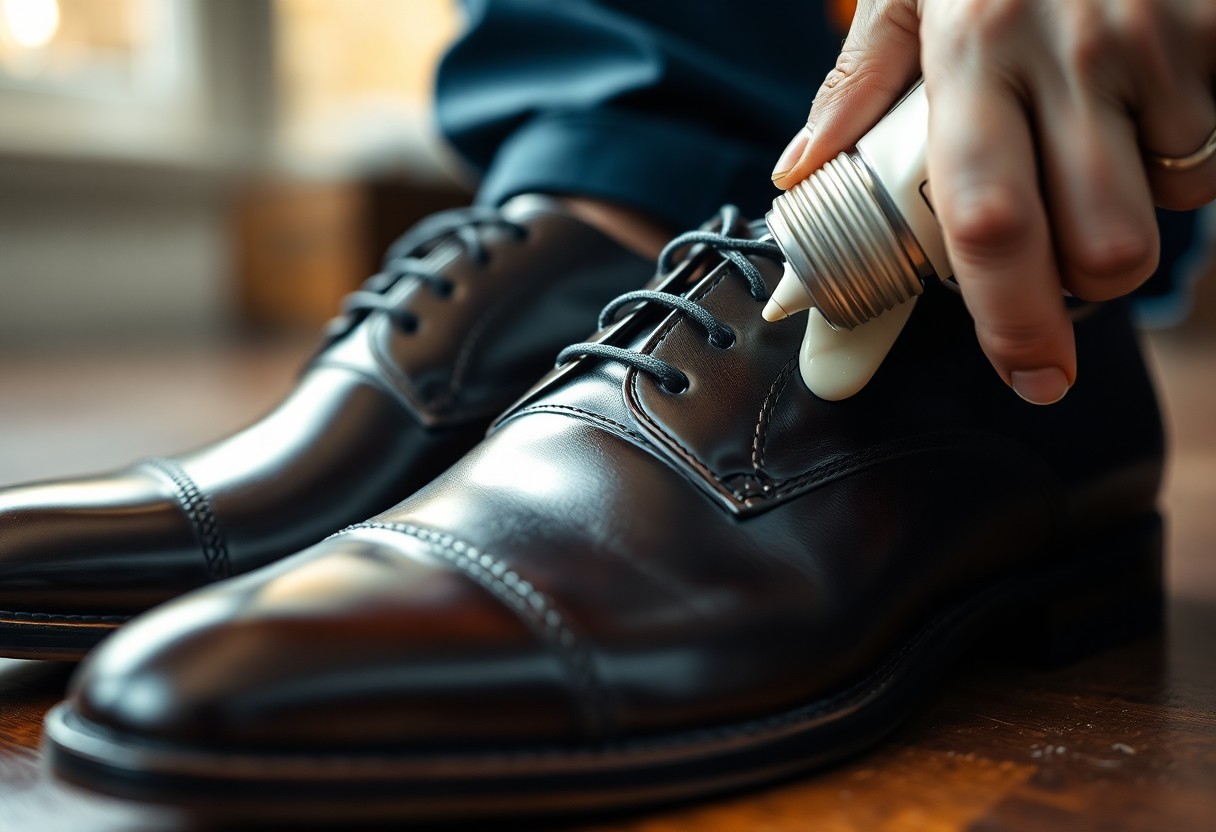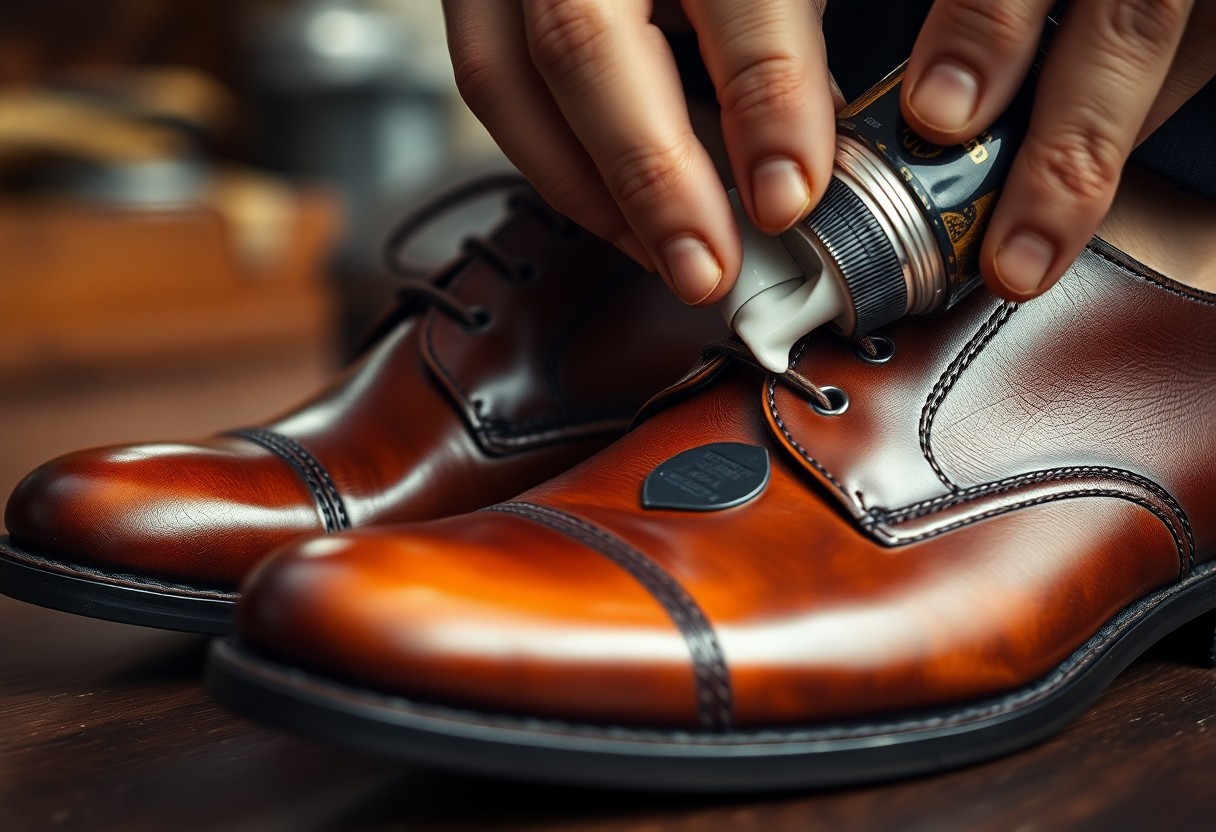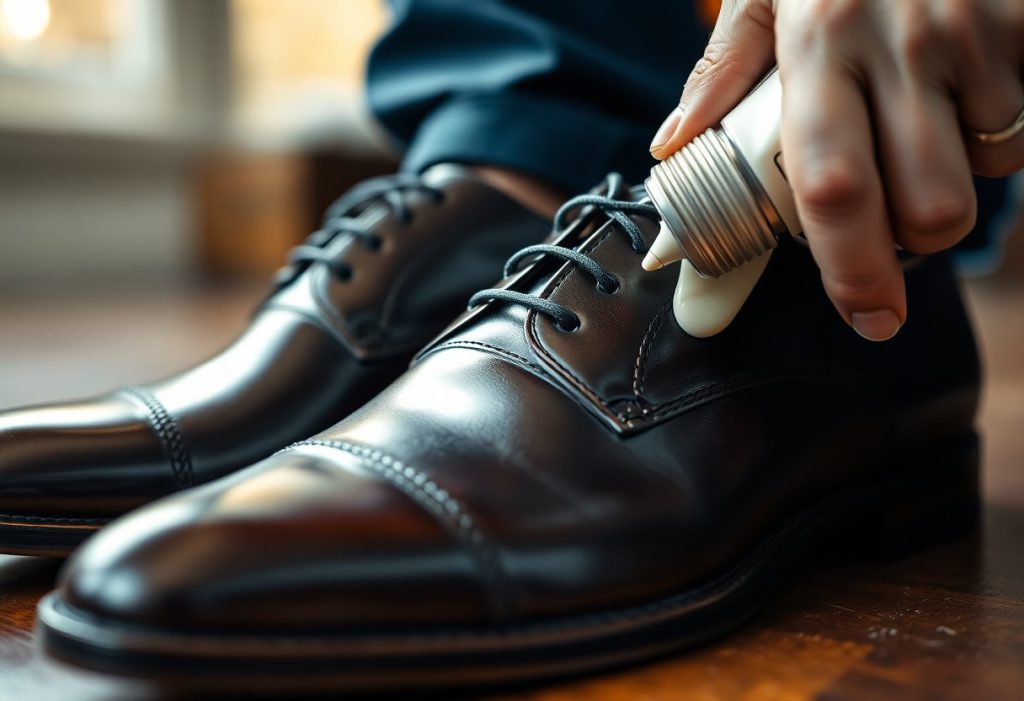Enhancing the aesthetic appeal of your leather shoes with darker shoe cream can transform them into a stylish and elegant accessory. By applying several thin layers of cream in increasingly darker tones, the final result can mimic a professional touch. It’s crucial to start with a cream shade that closely resembles the original color of your shoes to avoid any mismatched or uneven tones. For optimal results, select premium pigmented creams from trusted brands like Saphir Medaille d’Or or Boot Black. This method works particularly well on lighter-colored shoes, where you will appreciate the most dramatic transformation while preserving a natural look.
Comprehensive Guide to Materials and Steps for Shoe Color Enhancement
To effectively enhance the color of your shoes, it’s imperative to have a well-organized setup along with top-quality materials. Begin by creating a clean and well-lit workspace where you can focus on the task at hand, ensuring you allocate sufficient time for applying multiple layers of cream. Prior to starting the coloring process, your shoes must be thoroughly cleaned and completely dried. This preparation step is crucial in achieving an even and durable finish that will last over time.
Essential Tools for the Perfect Shoe Cream Application
To minimize the risk of errors during your shoe color enhancement journey, gather the essential tools you will need: application brushes, polishing cloths, and masking tape to protect the soles of your shoes. Additionally, ensure you have high-quality, pigmented shoe creams such as Saphir Medaille d’Or or Boot Black readily available. It’s also important to include cleaning supplies and a reliable leather cleaner to prepare your shoes thoroughly before applying the cream, ensuring the best possible results.
Choosing the Right Cream Colors for Effective Shoe Transformation
As you embark on the journey of enhancing your shoe color, it’s vital to select shoe creams that allow you to gradually build up to your desired shade. Start with a cream color that closely resembles the original tone of your shoes, and then move on to darker hues. For light-colored shoes, this methodical approach is key to preventing any uneven coloring that could compromise the overall aesthetic of your footwear.
The selection of both tools and cream colors will significantly affect your final results. Your cream choices should include a base color that matches the original shoe shade, plus two to three darker shades for layering. By using high-quality pigmented creams from reputable brands like Saphir, Boot Black, or Collonil 1909, you can achieve optimal color enhancement. Lighter shoes will allow for a more pronounced darkening effect, while darker shoes may require subtler adjustments.
Applying Color Theory to Achieve Professional Shoe Coloring Results
Understanding how colors interact is crucial for attaining a polished finish when darkening your shoes. Familiarity with basic color theory can help you avoid common mistakes, such as uneven application or selecting inappropriate shades. By using the color wheel, you can gain insights into the relationships between various shades like browns, blacks, and burgundies, simplifying the process of predicting how different shoe creams will influence the final look of your leather footwear.
Gradual Transitioning from Light to Dark Shades for Optimal Outcomes
One of the most important principles in shoe coloring is the gradual transition from lighter to darker shades. Your success hinges on making small, incremental adjustments. For example, a light brown shoe can be progressively changed to medium brown and finally to dark brown, but this process cannot be reversed. Each layer of cream should be slightly darker than the previous one to ensure the best possible results.
Understanding Color Depth to Achieve Superior Results
Darker shoe creams contain higher concentrations of pigment, enabling them to dramatically change the appearance of your shoes. Always conduct a test on a small, inconspicuous area prior to applying cream to the entire shoe. Quality creams like Saphir Medaille d’Or or Boot Black provide enhanced color control and more consistent outcomes.
The effectiveness of your color enhancement process is closely tied to the techniques you employ during layering. Applying multiple thin layers yields superior results compared to a single thick coat. Start with 2-3 layers of a lighter shade before moving on to darker tones. This technique guarantees even coverage and minimizes the risk of patchy or blotchy results that could detract from your shoes’ overall appearance.
Critical Pre-Treatment Steps for Effective Shoe Cream Application
Before applying darker shoe cream, following a specific sequence of preparatory steps is essential. Ensure your shoes are completely dry and at room temperature to facilitate optimal cream absorption. This preparation phase should include the removal of any old polish, a thorough cleaning of the surface, and the protection of areas you wish to keep uncolored. Adhering to these initial steps will help prevent uneven coloring and result in superior outcomes.
Thorough Cleaning Techniques for Optimal Surface Preparation
To begin, it’s imperative to conduct a comprehensive cleaning of your shoes. Use a leather cleaner to remove all dirt, old polish, and oils effectively. Your cleaning process should be gentle yet thorough, paying special attention to creases and seams where residue tends to accumulate. Achieving a pristine surface allows the shoe cream to penetrate evenly, promoting a flawless finish that enhances the shoe’s overall appearance.
Effective Masking Techniques for Protecting Your Shoes
Proper masking of your shoes is crucial for achieving a professional result. Be sure to protect the sole edges, welts, and any contrasting stitching using masking tape. This precaution will prevent unwanted staining and help maintain the original aesthetics of these components.
Surface protection involves careful application of masking tape along the edges where the upper part of the shoe meets the sole. Cover any decorative features or light-colored stitching that you want to preserve. Based on experiences with Midas boots and TLB Mallorca Artista shoes, effective masking can save hours of cleanup and yield clean, professional results.
Systematic Application Process for Darkening Your Shoes
To achieve outstanding results when darkening your shoes, it’s essential to follow a methodical approach. This process involves gradually building color using high-quality pigmented shoe creams. Light-colored shoes are generally easier to darken, but they also require careful attention to detail to prevent uneven coloring. Your success will largely depend on the tools you select and your commitment to applying multiple thin layers instead of a single thick coat.
Establishing the Base Layer for Effective Color Enhancement
This step represents the foundation of your color enhancement journey. Begin with a shoe cream shade that closely matches your shoe’s original color. Utilize an application brush to handle the edges and a polishing cloth for the main surfaces. Always protect the sole edges and stitching with masking tape to avoid any unwanted staining. Your first layer serves as a smooth base for the deeper colors that will follow.
Deepening Color Through Layering Techniques
As you add multiple layers, gradually incorporate darker shades into your application. Focus on applying thin, even layers using high-pigment creams like Saphir Medaille d’Or or Boot Black. Apply 2-3 layers of each shade before transitioning to a darker hue. This technique ensures your shoes develop a rich and uniform color that enhances their overall appeal.
Further enhancement relies on proper technique and patience. The ultimate results are determined by how effectively you work the cream into the leather. Utilize circular motions with your cloth to ensure even distribution of the cream. Allow each layer to dry completely before applying the next, as this method can transform light brown shoes into deeper tans or enrich burgundy tones.

Mastering the Multi-Layer Technique for Effective Color Enhancement
Not all color enhancements need to be completed in a single session. Your success is dependent on patience and gradual application. This technique involves applying multiple thin layers of shoe cream, starting with lighter shades and progressively transitioning to darker ones, which ensures an even and professional finish.
Commencing with Initial Light Layers
The multi-layer application process commences with a shade that closely matches your shoe’s original color. Avoid starting with dark cream immediately, as this may lead to spotting and uneven coloring. Apply 2-3 thin layers of light-colored cream, allowing each layer to dry for approximately 15 minutes before proceeding to the next application.
Incorporating Darker Layers for Enhanced Depth
Once your light base is established, you can gradually introduce darker cream layers. Choose high-quality pigmented creams like Saphir Medaille d’Or or Boot Black for optimal results. Apply the cream using gentle circular motions to ensure complete coverage while avoiding excess product buildup.
For the best outcomes, pay special attention to hard-to-reach areas near the sole edges. Always test the cream on a small, hidden area first to prevent any unwanted color reactions. Continue layering until you achieve your desired shade, which typically requires 3-4 applications of the darker cream.

Vital Considerations for Successful Shoe Color Enhancement
Unlike standard shoe care, enhancing color necessitates careful consideration of leather properties and proper product selection. It’s crucial to understand your shoe’s base color, leather type, and the expected outcome before beginning the darkening process. The success of your color enhancement depends on your technique and patience in applying multiple thin layers.
Recognizing the Variability of Different Leather Types
Various types of leather respond differently to color enhancement:
| Leather Type | Color Enhancement Properties |
|---|---|
| Full-grain | Best absorption, leading to even results |
| Top-grain | Good absorption; requires careful application for best results |
| Suede | Not recommended for cream treatment due to absorption issues |
| Patent | Cannot absorb cream effectively, making it unsuitable for this process |
| Corrected-grain | Limited absorption; may lead to uneven results if not applied carefully |
Addressing Common Problem Areas During the Application
Common challenges often arise near seams, creases, and toe areas. It’s essential to apply cream with extra caution in these zones to avoid excessive color buildup. Identifying potential problem spots beforehand will assist in preventing uneven coloring, contributing to a more polished finish.
At the beginning of your color enhancement project, test the cream on a small, hidden area to evaluate its effects. Your meticulous attention to detail in these sensitive areas will significantly influence the final quality of your shoe’s appearance. Pay extra care to the welt area, where excess cream can easily accumulate.
- Apply lighter coats to creases for even coverage
- Steer clear of heavy buildup near stitching
- Utilize masking tape to protect the soles throughout the process
- Work in small sections for optimal results
Common Questions About Enhancing Shoe Color Effectively
How should I start the process of darkening light-colored shoes with shoe cream?
Begin by selecting a shoe cream color that closely matches the original shade of your shoes. Apply several thin layers using high-quality, pigmented shoe cream brands such as Saphir Medaille d’Or or Boot Black. Ensure you cover the sole edges and stitching with masking tape for added protection. Start with 2-3 layers of the lighter shade before moving on to darker colors.
What tools are recommended for applying shoe cream during the color enhancement process?
Utilize an application brush for reaching difficult areas near the sole edges, and a polishing cloth for the main surfaces to aid in distributing the cream evenly into the leather. These tools help ensure complete coverage and a smooth application across all areas of the shoe.
How can I guarantee an even color result when darkening my shoes?
To achieve a uniform finish, apply multiple thin layers instead of one thick layer. Start with a lighter shade and gradually transition to darker shades. Use gentle, circular motions with your cloth to work the cream thoroughly into the leather, allowing each layer to dry completely before applying the subsequent one. This approach effectively prevents spotting and ensures a smooth, cohesive finish.
The Article How to enhance shoe color using darker shoe cream tips for a polished look appeared first on My Shoes Finder
The Article Enhance Shoe Color with Darker Shoe Cream Tips for a Polished Look Was Found On https://limitsofstrategy.com


I really appreciate your insights on enhancing leather shoes with darker shoe cream! I’ve found that this method not only improves the shoes’ appearance but also revitalizes them, adding life to a pair that might otherwise look tired. My favorite experience was when I transformed a pair of light tan oxfords into a deep mahogany; the impact was stunning!
It’s great to hear how much you enjoyed that transformation with the oxfords! Darker shoe cream really does work wonders, doesn’t it? It’s almost like giving the leather a new lease on life. I’ve had a similar experience with an old pair of brogues that had seen better days. I decided to use a dark brown cream and was honestly amazed by the depth it added. It’s incredible how something as simple as shoe care can elevate not just the shoes but also how you feel when you wear them.
It’s great to hear how a touch of darker shoe cream can breathe new life into your shoes; speaking of maintenance, I recently read about some shoe tree options that might just be worth considering for keeping those rejuvenated pairs in top shape.
‘Avoid Spiral Shoe Trees for Superior Alternatives’
https://thetokyoblonde.net/avoid-spiral-shoe-trees-for-superior-alternatives/.
It’s great to hear about your experience with transforming those light tan oxfords into a deep mahogany. That kind of transformation can be a real game-changer for a pair of shoes. It’s fascinating how a little shoe cream can completely alter not just the color but the vibe of the shoes as well.